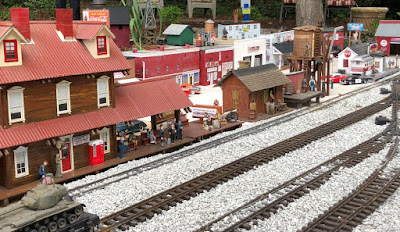I'm going to take a brief break from garden railroads to talk about the
General and the
Texas. If you aren't familiar with these two locomotives, they were involved in the Great Locomotive Chase on April 12, 1862.
Long story can be found on Wikipedia and many, many other sources. Short story: Small group of U.S. soldiers led my a civilian successfully infiltrate Confederate occupied territory, steal a fast locomotive
(General) along with a few boxcars of explosives in Marietta, Georgia and take off for Chattanooga with the plan to blow up a few railroad bridges on the way. The conductor of the hijacked
General pursues the stolen locomotive using a hand truck, then using a locomotive
(Yonah), and then a another locomotive
(William R. Smith), and then a third one
(Texas) and finally catches up with and captures the U.S. Army soldiers, due in large part to some truly stupid moves by their civilian commander. Many of the captured U.S. soldiers are executed. The soldiers who survive are the very first recipients of the U.S. Medal of Honor and those who were executed are eventually awarded medals posthumously.
None of the four locomotives involved were that unusual, but are famous because of this one incident on one day back in 1862. After the war, all went back into service on railroads. Two of the locomotives had rather inauspicious ends -- the
Yonah was likely turned into a stationary boiler in Atlanta around 1873, and the
William R. Smith likely had a similar end. In time, as the story of the Great Locomotive Chase became more familiar, the value of the two surviving locomotives was recognized and both were eventually preserved. There have even been custody fights over both locomotives as their value has increased over time. Both have gone through multiple changes and restoration processes.
I'm familiar with the story and I've seen both locomotives before, but this week was a special treat as I had the chance to visit the
General on Wednesday at the
Southern Museum of Civil War and Locomotive History in Kennesaw. And then on Thursday I attended a wonderful presentation at the NGRC about the details of the chase, presented as first-person accounts from the perspectives of the two main characters, with costumes no less! And then on Saturday I visited the
Texas at the
Atlanta History Center. The
Texas was recently restored at the
North Carolina Transportation Museum in Spencer, N.C. (where I saw it two years ago) and returned to Atlanta last year. It's not yet open to the public but I had the opportunity to get up close during a behind-the-scenes tour. Enjoy the pictures!
 |
| The General is in a gallery that doesn't quite allow a full side view. |
 |
| View from above showing the loaded tender. |
 |
| View of the General's cab. |
 |
| The Texas in its new home at the Atlanta History Center. It's new home has glass on three walls, providing lots of natural light and allowing the locomotive to be viewed from outside. |
 |
| Here's a view from the other side. Note the access ladder on the side which will allow visitors to climb into the cab. |
 |
| The Texas was restored to look mostly like it did around 1886, rather than what it looked like in 1862. By 1886 it had been assigned number 12, and had been converted to standard gauge. |
 |
| The Texas was a much smaller and simpler locomotive than the General. Compare this cab view with the one above. |
 |
| Detail view of the steam gauge. |
 |
| A close-up showing some of the shiny new brass parts. This locomotive has been lovingly restored and probably looks better today than anytime since it first rolled out of the factory in 1856. |
 |
| Close up view of the headlight. |
 |
| Here's a picture of the Texas while it was undergoing restoration in the Spencer shops at the North Carolina Transportation Museum, when I visited in April, 2016. Note that it was numbered 49 at this time, which it was given in 1866. |
 |
| A rear view of the Texas during renovation. |

























































